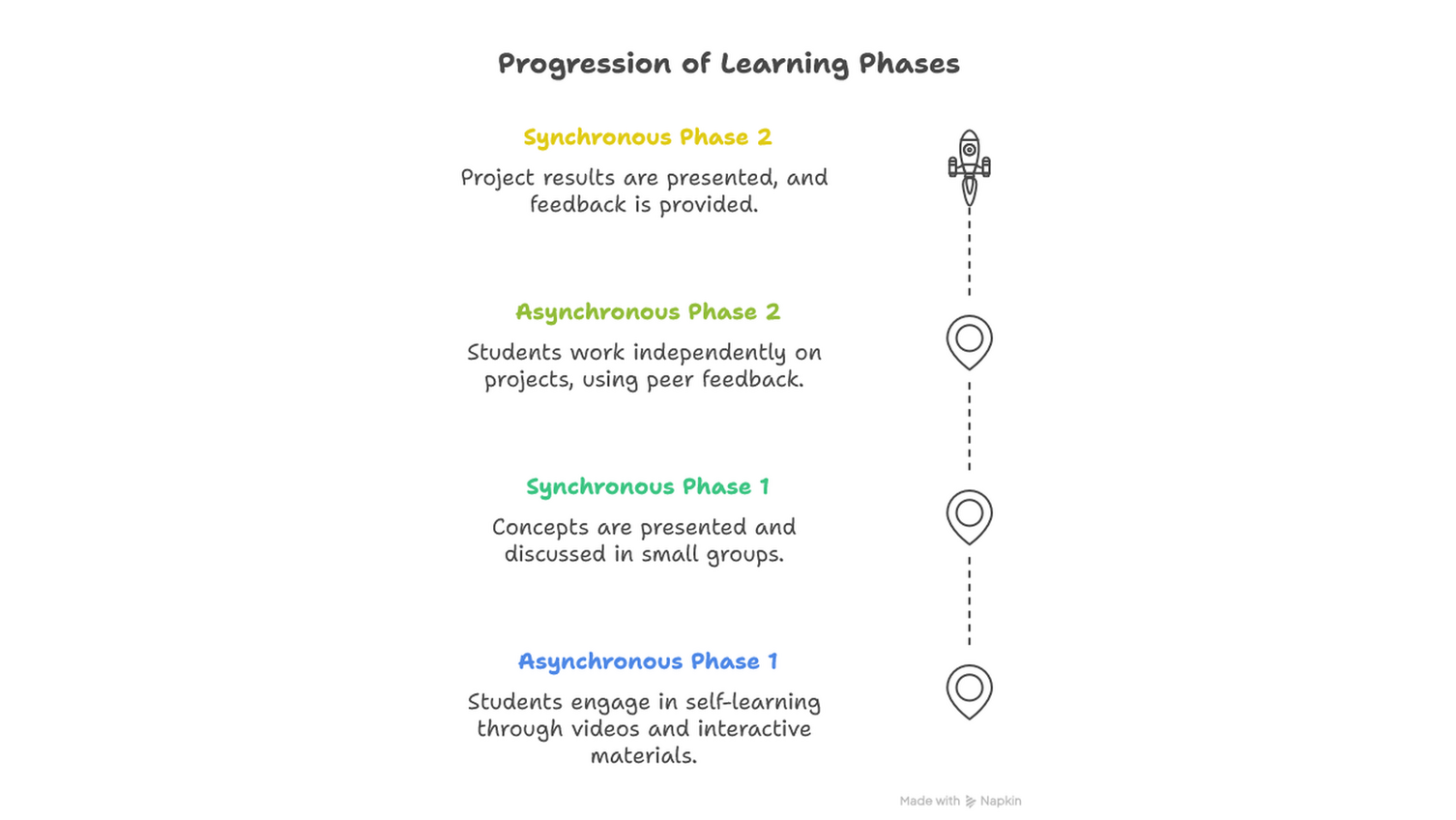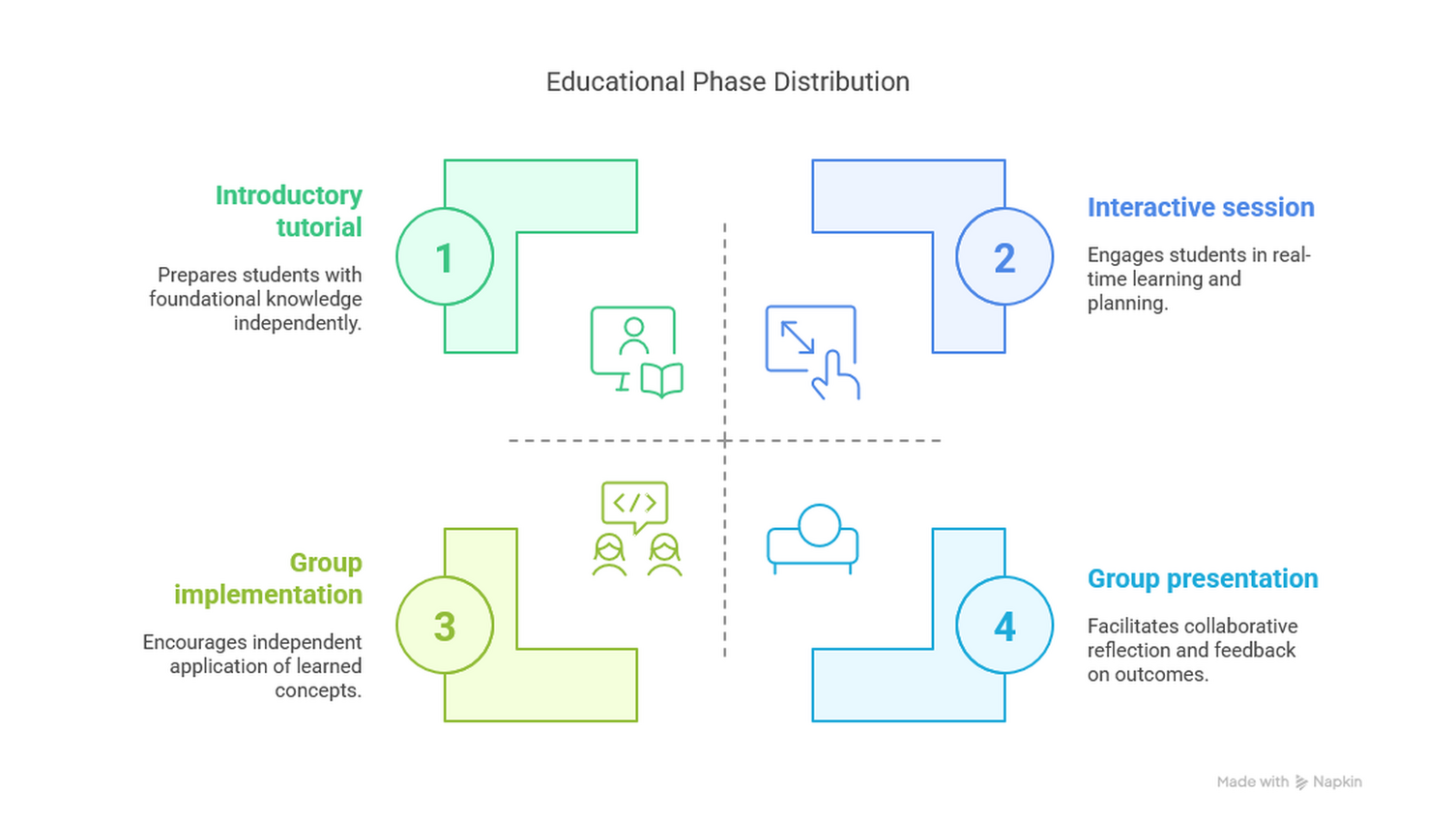Blended Learning and Flipped Classroom
Blended learning is a concept that combines face-to-face teaching with media-based elements. It includes both synchronous learning (e.g. video conferencing) and asynchronous learning (e.g. self-directed work). A related concept is the flipped classroom, in which students work on the basics asynchronously at home and use synchronous phases on site for in-depth (group) work.
Blended learning offers advantages such as more flexibility in terms of time and location, as well as the opportunity for students to set their own learning pace. However, it is important that synchronous and asynchronous phases are well coordinated (interlinked), i.e. that they refer to each other through materials or methods.
On this website, you will find general information about blended learning, approaches to effectively combining phases of your course, information about the related concept of the flipped classroom, and corresponding scenarios.
Blended learning, also known as integrated learning, describes a form of learning in higher education that combines classroom teaching with forms of e-learning in a didactically meaningful way. The aim is to enhance the advantages and minimise the disadvantages of different media and methods by combining them in a suitable way.
Here we provide you with tips on how to structure your course from different phases and how to effectively interlink the phases.
- Communicate a clear goal for the phases: Show students how asynchronous preparation and follow-up are incorporated into classroom teaching. Explain the benefits of self-learning phases, e.g. as a basis for active participation in the synchronous phase.
- Create seamless transitions: Use tools such as a forum or digital pinboards to integrate insights from the asynchronous phase into your face-to-face teaching. For example, you can incorporate quiz results directly into discussions.
- Build in feedback loops: Give students the opportunity to validate the results of their self-learning in the classroom, for example, through peer feedback or direct feedback from the teacher.
- Formulate connecting tasks: Set tasks that are prepared in the asynchronous phase and applied or deepened in the synchronous phase, for example, through joint group projects or discussions.
- Use digital tools in a targeted way: Use digital tools such as surveys, collaborative documents or quiz platforms to pick up on the content of the asynchronous phase and link it to the synchronous phase.
- Encourage interactivity: Plan interactive elements based on the students' preliminary work, e.g. discussions, simulations or role plays, during the face-to-face phase.
- Gather feedback: Regularly collect feedback from students on how they perceive the interlinking, and adapt your approach to make the connections clearer and more motivating for students.
- Support self-learning: Support self-learning phases by providing tips on how students can learn well on their own.
Scenario 1: Preparation and consolidation with a quiz
- Asynchronous phase (independent learning): Students work through an interactive quiz on the learning platform (e.g. Moodle) on the basics of a topic. The quiz contains both knowledge questions and reflection tasks. In addition, there are short videos with illustrative examples. Students research material and methods to prepare a project.
- Synchronous phase (face-to-face teaching): The results of the quiz are discussed together. The teacher answers open questions and students carry out an in-depth project in which they apply the basics they have researched in a practical way.
Scenario 2: Discussion and case studies
- Asynchronous phase (self-learning): Students read a case study and write a short summary or statement in a discussion forum.
- Synchronous phase (face-to-face teaching): The teacher moderates a discussion based on the contributions in the forum. Afterwards, the students work in groups on an extended case study dealing with more complex scenarios.
Scenario 3: Project work with peer feedback
- Asynchronous phase (self-learning): The students work in small groups to develop a draft for a project or a solution to a problem. This is done on the basis of provided guiding questions or instructions.
- Synchronous phase (face-to-face teaching): Each group presents their drafts. This is followed by a peer feedback process, moderated by the teacher, in which groups give each other suggestions for improvement.
Scenario 4: Practical application with learning control
- Asynchronous phase (self-learning): Students work on a learning task, e.g. a simulation or a coding assignment. Tutorials and explanatory videos are provided to support them.
- Synchronous phase (face-to-face teaching): The results of the learning task are presented and analysed. Open questions or difficulties from the asynchronous phase are clarified in a Q&A session.
The flipped classroom, also known as the inverted classroom, is a teaching method that reverses traditional roles:Instead of having the teacher convey content in the teacher event, students work on this content regardless of location using the provided materials such as videos, texts or podcasts. The time spent at the university is then used to deepen and apply the acquired knowledge through practical exercises, discussions or projects, with the teacher acting as a supportive moderator.
This concept promotes active student participation and enables more intensive engagement with the subject matter during the time spent together in class.
The OER portal Twillo offers a template for Flipped Classrooms that you can import into your Moodle room. The didactic template includes stage directions that give you important information about what you should consider in each learning unit. The template is suitable for any subject area.
Scenario 1: Introduction to a complex topic with project work
- Asynchronous phase 1 (self-learning):
- Students watch videos or work with interactive materials that explain the basics of a topic (e.g. introduction to statistics). They answer comprehension questions and create a short concept for a question that builds on the basics.
- Synchronous phase 1 (face-to-face teaching):
- The concepts are presented and discussed in small groups. Open questions and problems from the first asynchronous phase are clarified in a moderated Q&A session. A complex project task is then set.
- Asynchronous phase 2 (independent learning):
- The groups work independently on a project, for example, documenting their progress and uploading it to a digital platform. They can use peer feedback to improve their approaches.
- Synchronous phase 2 (face-to-face teaching):
- The groups present their project results. The teacher provides targeted feedback and moderates a discussion about alternative solutions or their practical implementation.
Scenario 2: Critical analysis of an article
- Asynchronous phase 1 (independent learning):
- The students read a scientific article or case study and write a short analysis or opinion on the central theses. This is uploaded to a discussion forum.
- Synchronous phase 1 (face-to-face teaching):
- The teacher moderates a discussion based on the submitted comments. In small groups, students develop additional questions or hypotheses that expand on the article.
- Asynchronous phase 2 (self-learning):
- The students research the questions developed in the plenary session and create a shared document (e.g. a wiki or a presentation).
- Synchronous phase 2 (face-to-face teaching):
- the groups present their results and the teacher leads a reflection on the entire analysis process to consolidate the results.
Scenario 3: practice-oriented problem solving
- Asynchronous phase 1 (self-learning):
- the students work on an introductory tutorial to a practical problem (e.g. data analysis with a new tool). They solve simple tasks that prepare them for a more complex challenge.
- Synchronous phase 1 (face-to-face teaching):
- The teacher guides the students through an interactive session in which the tool is used together, and the students understand the more complex challenge and plan it in group work.
- Asynchronous phase 2 (self-learning):
- The groups implement the planned solution independently and document the solution and the results in a digital workspace.
- Synchronous phase 2 (face-to-face teaching):
- The groups present their results. Together, they reflect on the difficulties that arose and which solutions were particularly effective.
Scenario 4: Developing a line of argument
- Asynchronous phase 1 (independent learning):
- Students are shown an introductory video on how to construct a line of argument (e.g. Toulmin model). They apply the model to an example and submit it as text or graphics.
- Synchronous phase 1 (face-to-face teaching):
- The submitted models are discussed and compared. Students work in groups to develop an extended model for a new question.
- Asynchronous phase 2 (independent learning):
- The groups improve their model based on feedback from the synchronous phase and create a digital visualisation (e.g. a mind map or diagram).
- Synchronous phase 2 (face-to-face teaching):
- The final argument models are presented and critically discussed. Finally, the models are synthesised into a common solution.
What makes these scenarios special
The two asynchronous and synchronous phases are designed in such a way that they build on each other in a targeted manner. Students have to actively participate and work independently, while the synchronous phases are used for in-depth interaction and feedback. The clear structure and continuous connection of the phases ensure that students perceive the learning process as holistic.


